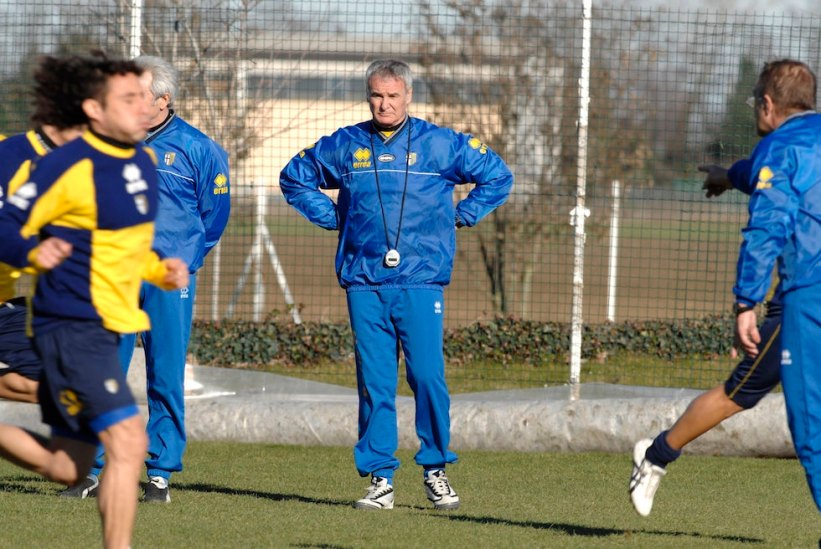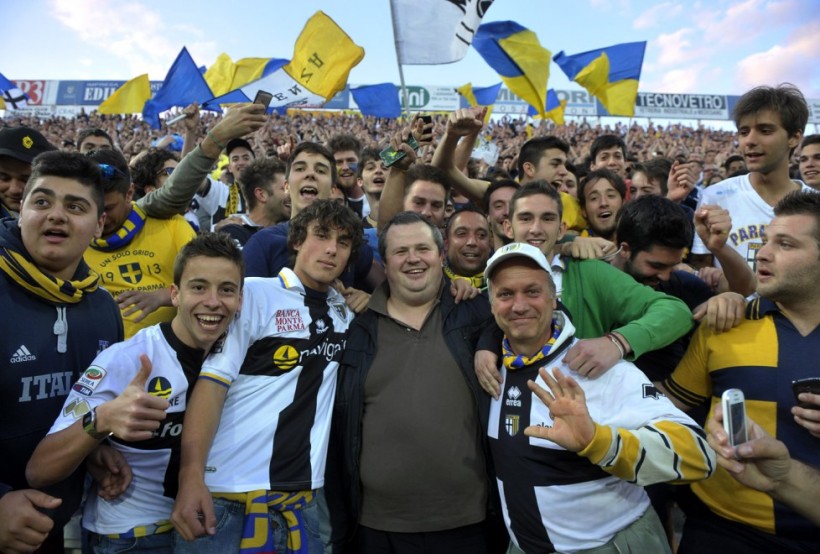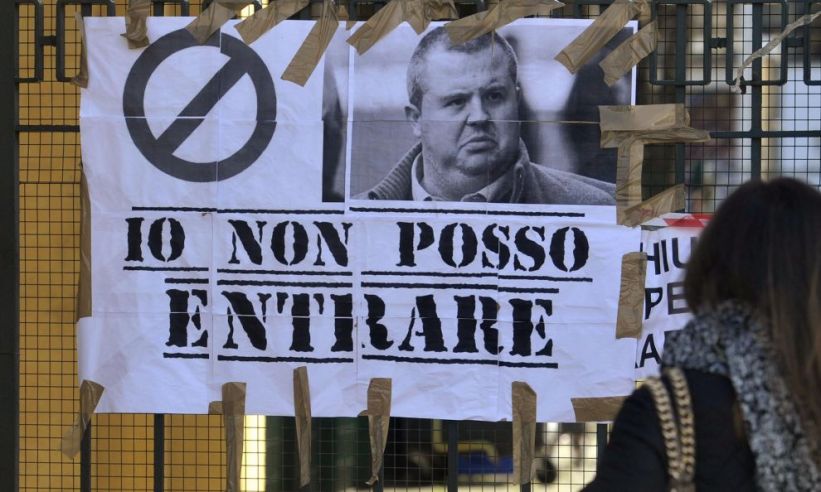As the camera panned around, the pictures on the wall started to come into focus. On them were scenes of glory, ecstasy and passion. A few were from generations long passed; nothing more than a fleeting memory. Many more, however, were still fresh in the mind, with the sights and sounds giving rise to goosebumps even now.
As the camera ventured down the vacant corridors an eerie sensation washes over the viewer, made even more touching by the song ‘The End’ (by the ‘The Doors’) playing in the background. Here was a multi-million-euro complex lying completely vacant. The restaurant, once a hub of laughter and comradery, where so many players – young and old – had come to be fed after training, was silent. The chairs were all neatly stacked upon the tables. And as the video comes to its solemn conclusion, the camera focuses in on one picture in particular. A picture from happier times, when both players and officials met Pope Francis at the Vatican. However, it is not Pope Francis who the camera zooms in on, but rather the man sitting beside him. The man who had caused so much bitterness and pain, the man who had brought down one of Italy’s most storied clubs; Tommaso Ghirardi.
Even in a country which is notorious for producing shady club presidents, Tommaso Ghirardi went above and beyond the call of duty, ensuring he was one of the shadiest of them all. While many presidenti have ultimately met an unceremonious fate, few have gone from hero to villain status as quickly as the 41-year-old Brescia native. But to get to that point, we must first take a step back.
By 2007, Parma football club was but a relic of its former glory filled days in the 1990’s. The downfall of the Parmalat empire, which had bankrolled the club, had ripped the heart from the Gialloblu, leaving the club on life support. For three years, Parma struggled forward in the limbo that was controlled administration, constantly seeking a buyer. At one stage, it looked as if former Real Madrid president Lorenzo Sanz was set to step into the void and take over the club. That deal, though, would eventually fall through, leaving the door open for another to enter. Enter the youthful Tommaso Ghirardi. Despite being only 32 years of age, the entrepreneur from Brescia arrived with experience under his belt, having already run a football club, albeit one of far less grandeur then Parma.
Nonetheless, he had proven himself a more then capable owner during his spell at Carpenedolo, a small club from just outside Brescia. Under his guidance, the club were promoted into the professional ranks for the first time in its then 47-year history. Now, though, Ghirardi was seeking bigger fish to fry, and Parma fitted that mould perfectly. Having arrived with the club in a perilous state, both financially and on the pitch, Ghirardi wasted no time in getting his house in order. Current Inter head-coach Stefano Pioli, who was then in charge of the Ducali, was given the heave-ho after only two matches and replaced with Claudio Ranieri.
The tinker man, as he was ungracefully known, faced a monumental task in keeping the Crociati in Serie A. In truth, many had already resigned themselves to relegation, but Ranieri somehow galvanised his charges to achieve the seemingly impossible and retain Parma’s Serie A status for an 18th consecutive year. It was and remains one of the most remarkable modern day escapes in Serie A history.
Claudio Ranieri in training during his brief, yet successful, spell at Parma
That summer, Ghirardi invested heavily in the squad, no doubt hoping to secure Parma’s place at the top table for years to come. He would, however, have to do it without the services of Ranieri, who had moved on to pastures new. This ultimately proved fatal for the club, as the tinker man’s replacements proved wholly un-up to the job. And by the final match day of the 2007-08 season, Parma sat mired in the relegation zone. Survival was still a possibility, but it required a win against title chasing Inter, as well as other results to go their way. In the end, the Crociati failed to live up to their end of the bargain, losing 2-0 at home to Inter. As the Nerazzurri players and fans celebrated the Scudetto, the reality of relegation was only just setting in for the Parma supporters and Ghirardi.
Promotion back to the top flight would be achieved at the first time of asking, but it proved far from plain sailing, with Ghirardi once again having to step in and sack another coach. Things, however, looked to be on the up for the club; now back in Serie A and seemingly on sound financial footing, the potential for growth looked promising.
Along with the promotion, Ghirardi also thought it prudent to hire a new Director of Football, in the shape of Pietro Leonardi. This would prove to be the move that brought about the destruction of Parma Football club. Leonardi had previously worked at Udinese under the Pozzo family, and was a big exponent of the Udine philosophy. This involved mass scouting, procuring the services of underrated but talented players, and later selling them on at a large profit.
As the years passed, Ghirardi and Leonardi turned the Ducali into a lighter version of the Zebrette. However, while Udinese’s owners would go on to buy other clubs such as Granada and Watford, interchanging players between each club whilst also still selling players for profit, Parma headed down another route. Instead of purchasing another club, Ghirardi and Leonardi decided it was best to just strike up agreements with smaller clubs such as Gubbio, Paganese and Slovenian side, ND Gorica. It was to prove one almighty mess. Parma began to acquire players at an alarming rate and quickly sent them out to their feeder clubs. By the time Parma went out of business, it was estimated that the club had some 150 to 200 players registered at the club.
However, little notice of this peculiarity was taken as on the pitch, as the Gialloblu continued to improve under the stewardship of Roberto Donadoni. What’s more, Ghirardi was a popular owner with the fans, having brought the club from the precipice to the doors of Europe. This would only make his later betrayal an even more bitter pill to swallow for Parmigiani.
Ghirardi (centre) pictured with supporters in Parma’s Curva Nord Matteo Bagnaresi
But before the betrayal came a moment of ecstasy. An amazing 2013-14 season saw the club finish sixth in the table and thus qualify for Europe. Yet even as it seemed that the good times were returning to Parma, the storm clouds began to ominously gather. A few weeks before European qualification had been secured, news began to filter through that Parma would not receive a licence to compete in the Europa League. The reason behind this rejection was seemingly a €100,000 outstanding tax payment. Ghirardi nonchalantly dismissed it as a minor issue and assured the fans that all would be okay. This was the first signs of the chaos to come.
As the weeks went by, it became clear that the Ducali would not receive the required licence, which proved puzzling as many believed the club to be on reasonably sound financial footing. This was all about to quickly be dispelled heading into the 2014-15 campaign. Ghirardi had kept a low profile as news began to emerge that players and staff had not been paid in months. With results on the pitch having fallen off a cliff, news slowly began to leak of the financial crisis that had engulfed the club once again.
By early December, Ghirardi had sold the club to what was believed to be some sort of Russian-Albanian-Cypriot consortium. It was the act of a desperate man trying to run from the problems he had created. Only a month later, the club was sold again after the consortium had claimed that Ghirardi had not fully disclosed the extent of the financial crisis facing the club, which, by this stage, was over €200 million in debt.
What came next is a story that has already been well told; Parma disintegrated under the weight of their debt and eventually went out of business.
Parma fans protested vehemently against Ghirardi, including taping a picture of the president at the entrance of the Stadio Ennio Tardini accomapnied by the message ‘I cannot enter’
The demise of the club not only had implications on a sporting front, but also on a human level. Many jobs were lost, while the club’s wholesalers and retailers were left in the lurch. This had lasting and detrimental effects on the local economy.
The hatred towards Tommaso Ghirardi remains very raw for all those connected with Parma. Initially seen as the club’s saviour after the Parmalat scandal, the fans had put their faith in him, only to be betrayed. This vitriol can still be heard emanating from the Curva Nord of the Stadio Ennio Tardini on match days, when Parmigiani sing:
‘Ghirardi, La Senti Questa Voce, VAFFANCUOLO’ – ‘Ghirardi, do you hear this voice, FUCK OFF’.
Author’s Note:
While in the process of writing this piece, an interview emerged in La Repubblica with former Parma Director of Football Pietro Leonardi. In this interview, Leonardi claimed that on his arrival, the club was already €100 million in debt. Given that Ghirardi supposedly took over the club debt-free, this would mean that the €100 million was incurred within the first two years of Ghirardi’s presidency.
If so, how were Parma able to function for so many years afterwards? Moreover, how was this not picked up by any of the relevant authorities? Of course, this could be the ramblings of a man desperate to clear his name, but it seems the tale of Parma’s bankruptcy still has a few more chapters to come.




One Comment